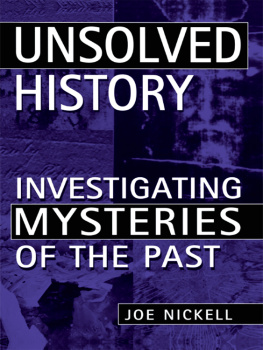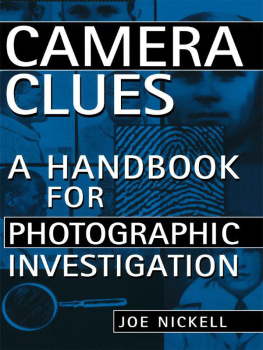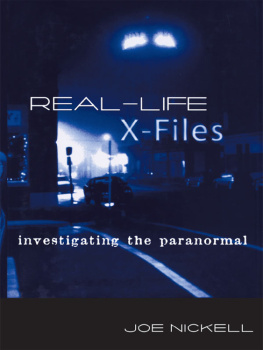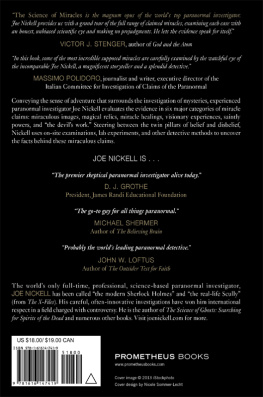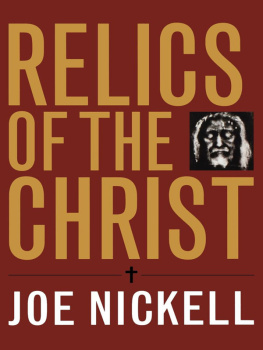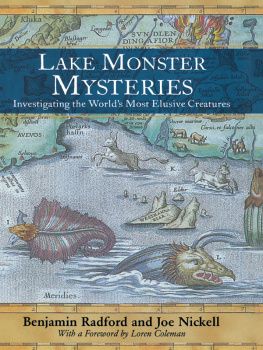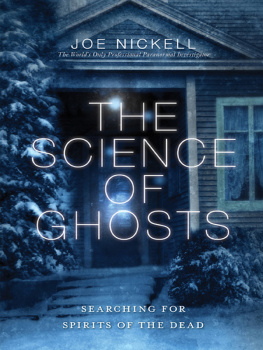ACKNOWLEDGMENTS
P ortions of this book first appeared in the authors doctoral dissertation, Literary Investigation: Texts, Sources, and Factual Substructs of Literature and Interpretation, University of Kentucky, 1987.1 am supremely grateful to the members of my dissertation committeeJohn T. Shawcross (director), R. Gerald Alvey, John Greenway, Michael Harris, Jerome Meckier, and Rupert Pickensfor their help.
I also wish to thank the following publications for permission to reprint several articles, which appeared in somewhat different form under the titles given: Skeptical Inquirer (editor, Kendrick Frazier) for The Nazca Drawings Revisited and Unshrouding a Mystery: Science, Pseudoscience, and the Cloth of Turin; Lincoln Herald (editor, Joseph E. Suppiger; Scott D. Millar, executive vice president, Lincoln Memorial University), for Lincolns Bixby Letter: A Study in Authenticity; Filson Club History Quarterly (editor, Nelson Dawson) for Uncoveredthe Fabulous Silver Mines of Swift and Filson and Daniel Boone Fakelore; and Free Inquiry (editor, Tom Flynn) for Mechanic of Death: The Case of Ivan the Terrible and Ivan Revisited.
In addition to those individuals mentioned in the text, I am also grateful to the late Robert H. van Outer and the University of Kentucky Photographic Services for photographic assistance, and the staffs of the Margaret I. King Library, University of Kentucky, and the John F. Kennedy Memorial Library, West Liberty, Kentucky, for research assistance as well as Timothy Binga, director, Center for Inquiry Libraries, Amherst, New York. Many others helped in various ways, especially three who have since passed awaymy mother, Ella T. Nickell, who typed the manuscript, my father, J. Wendell Nickell, and my great uncle, Milton C. Nickell, with whom I spent much fondly remembered time in historical pursuits.
INTRODUCTION
History and the Investigative Approach
M ans view of historythe worlds significant past eventsdoes not remain static. Just as science came to discredit the theory of geocentricism (the belief that the earth is the center of the universe) and to acknowledge the truth of reports that stones fell from the sky, so it is with historiography (the writing of history): One generations dubious legend may become anothers accepted historical factand vice versa.
Take ancient Troy, for example. That citadel of Asia Minor had been made famous by Homers epic poem, The Iliad, which related how the Greeks besieged Troy to rescue the beautiful Helen. Later pseudochronicles helped diffuse the legend of the Trojan War throughout western Europe. There even arose a patriotic tradition, lasting for a millennium, that the dispersed heroes of the tale had founded such Western nations as England and France.
Now the view has again changed, owing in part to the archaeological investigations of Heinrich Schliemann and others. In the 1870s Schliemann, a self-taught scholar, excavated what is now generally believed to be the fabled fortress of Troy. On the basis of much additional datanotably evidence that Troy was apparendy sacked by invading Greeks about the twelfth or thirteenth century B.C .the skeptical attitude toward the epic tradition has considerably softened.
Schliemann had set out with a determination to uncover evidence of Homers ancient world. His success was fabulous: In addition to the legendary city, he discoveredacross the Aegean Sea in Greeceroyal graves with astonishing riches. His successful approachwhich culminated in the unearthing of clear proof of the great culture we now know as Mycenaewas essentially a dramatic investigative one.
While the verbs research and investigate can be used interchangeably, and indeed may denote the same activity, the latter term connotes a particular type of scholarly or scientific examination or inquiry. Not only does investigation involve an attempt to bring information to light, but it implies a type of information that is particularly obfuscated. Thus we may speak of conducting paleontological research, but of investigating the mystery of the dinosaurs extinction. When there may be a suggestion of deliberate obfuscation, as in the clandestine or even criminal activities of individuals, the term investigate may seem especially appropriate. Therefore, while we research the effects of smoking or the causes of economic growth, we investigate a diversion of funds or a homicide. In short, the systematic seeking of knowledge is research, the attempt to solve a specific mystery an investigation.
We may extend the distinction to the historical arena. Thus historical investigation is defined as that aspect of research in which appropriate methodologies are applied toward the resolution of historical conundrums. For example, whereas one might refer broadly to Revolutionary War research, one would doubtless speak of an investigation to determine whether some questioned battle actually took place. Again, one may conduct research toward the writing of an important figures biography, but investigate an apparent secret in his or her life.
The results of historical investigation may solve cultural, political, biographic, or other enigmas, or may shed light on additional historical problems. While some of these results may become only footnotes to history, they obviate the need for further investigation, may open up new areas for study, and may enhance the interpretation of that which was already known.
Procedurally, just as with a problem in law or science, the investigation of a historical mystery may involve several potentially applicable hypotheses. As David Binder and Paul Bergman state in their legal text, Fact Investigation: From Hypothesis to Proof, Investigation is often all too readily thought of as merely a time to learn evidence. But remember that the evidence-gathering phase of investigation is normally preceded by analysis which ultimately dictates what evidence one pursues. This analysis concerns in part the potential legal theories and factual hypotheses that one may pursue during investigation.
The goal of the investigatorwho abandons or modifies hypotheses as necessaryis the development of proof, in favor of one hypothesis, that is sufficient to solve the original problem. The standard of proof or persuasion required to settle historical questions has not been codified but can be characterized by analogy to the two standards used in civil law.
The lower standard (equivalent to a preponderance of the evidence in civil cases) would be represented in historical matters by the establishment of the preferred hypothesis. Basically, this would mean arriving at the one hypothesis, among those that can be advanced, which appears to account for all the evidence or at least which explains more data than do competing hypotheses.
When more than one hypothesis can account for the known facts, the preferred hypothesis can be determined by invoking Occams razor. Named for William of Ockham, the influential fourteenth-century philosopher, this principle affirms that the simplest explanationthat is, the hypothesis with the fewest assumptionsis most likely to be correct and is to be preferred.
The second, or higher standard of persuasion would be comparable to that termed clear and convincing evidence in civil law. (The highest legal standardrequired in criminal cases and known as proof beyond a reasonable doubtwould seem impractical for historical questions, although such a standard might well be achieved.)
In any case, either the preferred hypothesis or the accepted theory may yet have flaws or leave some questions unanswered, so the mere raising of objections will be insufficient to remove it from its advantaged position. As Binder and Bergman state, regarding legal matters, In most cases, despite the fact that the plaintiff has the burden of proof, both plaintiffs and defendants present affirmative as well as rebuttal evidence. (In historical disputes, substitute advocate of the new idea for plaintiff, and for defendant read challenger of the assertion.) Therefore, it would seem appropriate that removal of a hypothesis or theory from its preferential position should come through development of a demonstrably superior hypothesis that would itself achieve advantaged status. Of course, evidence clearly fatal to a hypothesis or theory would cause its removal even in the absence of a replacement.

